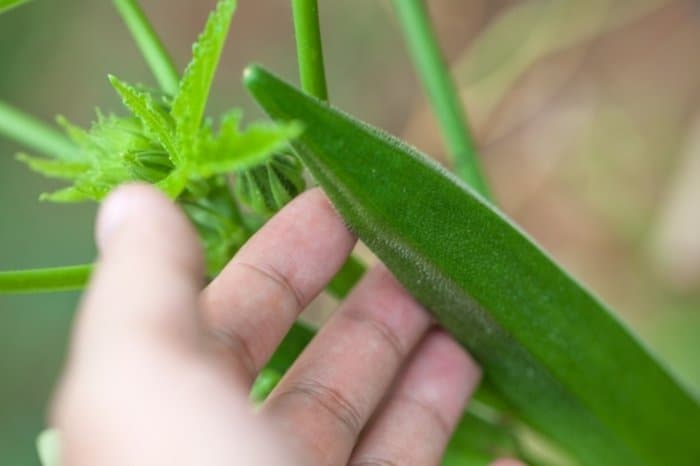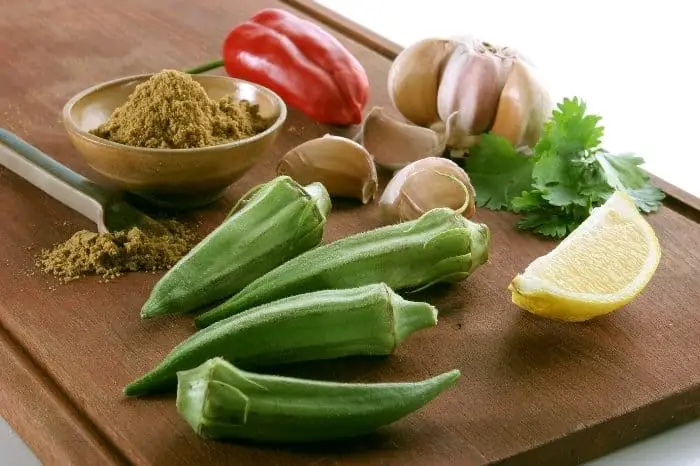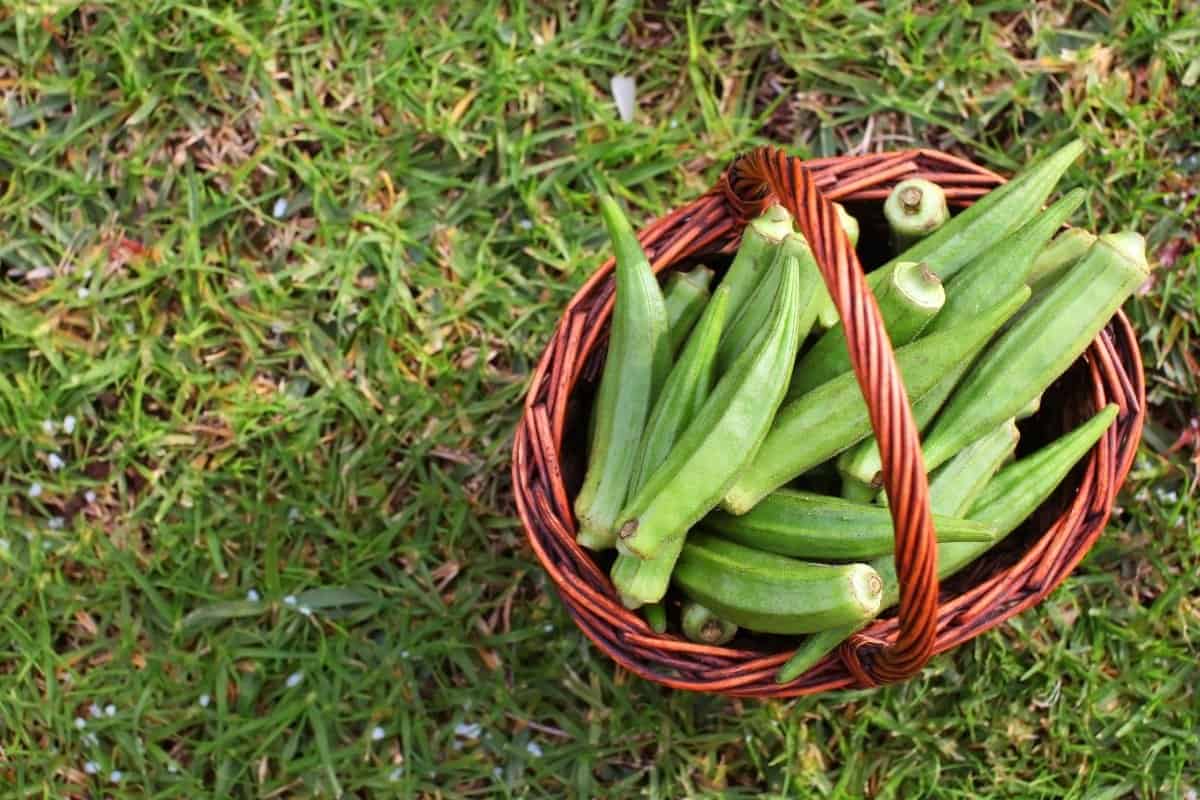Last Updated on February 4, 2022 by
So with your okra plant is thriving and starting to flower, but when is okra ready to pick, and how do you harvest it?
Let’s learn a few things about okra – growing, harvesting, and preserving seeds.
Growing okra is a simple task that anyone can undertake. Okra matures fast, especially if you have hot weather that the plant prefers.
Knowing when to pick okra is important, so you do not over or under grow them. Harvesting okra can be tricky because you have to harvest the pods before they grow tough.
It takes about four or so days from the flowering time to the time to pick okra. Once you start picking, harvest them every other day to keep their production high as long as possible.
When Is Okra Ready To Pick?
Okra is ready to pick when it has grown up to at least 2 to 3 inches long. If you leave them for too long, the pods can get hard and woody. When you finish picking okra, store them in plastic bags in the fridge.
Remember, you cannot keep okra in the garden, hoping to harvest them later; they will overgrow. Just harvest them at the right time and store them in the fridge or freeze them for later use. They will last about a week or so when fresh, but you can also freeze them if you have too much at once.
When Do The Pods Form?
After planting your choice of okra variety, it grows fast. On approaching maturity, pods begin to form a few days after flowering.
Once they have formed, check on them daily to see if they are ready. When they reach about 3 inches in length, they peak their flavor and tenderness.
At this point, they are ready to harvest. They may be able to hang around the plant a few days before they get tough.
How To Pick Your Ready Okra
Congratulations on growing your own okra this far. You now have a ready crop that is ready for harvesting. How do you harvest your okra?
- Wear gloves to help you handle the pods as little as possible. This prevents skin irritation and softening the okra before use. The okra plant has some small spines that can irritate your skin on contact. Even the spineless varieties have some setulose growth that also causes irritations. So to be safe, wear your gloves.
- If you find your okra is already woody when you pick, toss it into a dish for slow cooking, which may help soften them.

- Always pick your okras when they are 2 to 21/2 inches long. Remember, every time you pick; you encourage more growth; keep harvesting regularly.
- We understand it can be tempting to leave these fruits longer to see how large they grow. Unless you want to grow them for a floral arrangement or seeds, then don’t do it.
- The longer they grow, the tougher they are. The pods become woody, the spines firmer, and the stems harder to cut.
- Use a sharp knife to cut them from the plant, so you don’t injure the plant.
- Okra is self-pollinating so that you can save up some plants for seeds in the following year. It will make a great crop for the second time around.
Saving Seeds For The Next Planting Season
Instead of eating all the okra, you may want to save some pods from growing into seed. Harvest your okra when they are fully mature and almost dry.
Remember, these will have grown past the eating stage, so you cannot eat them. Leaving the pods to mature for seed slows down the growth of new pods, so you might not have any more to eat from the plant.
Sow Right Seeds – Emerald Okra Seed for Planting – Non-GMO Heirloom Packet
This is a great way to save seeds instead of buying new ones each planting season. Your seeds will produce a replica of your previous crop, so make sure you had a good crop. If you do like the crop, don’t save the seeds; rather, get fresh hybrid seeds.
You can also use these plants as floral arrangements – cut a bunch of stems, wrap them into twine and suspend them upside down to dry. These are for use in your floral arrangements and can last for a long time. Get creative with them and add some color or go to Pinterest for some floral décor ideas.
Enjoying Ready Okra
Okra is a yummy dish and can be used with a variety of dishes. It is well known as an ingredient for gumbo which is common among many homes.
It can be sliced and added to other soups and stews as a thickening agent. You can fry it and eat it whole or sliced. You can make fresh okra pickles that can be served alongside fish or fried chicken, or burgers.
The okra recipes are many. You can either chose to eat it in its natural slippery state or hide the texture by coating it and making it crunchy.

To reduce the slimy texture of okra, try soaking it in lemon juice or vinegar for about 30 minutes before cooking. You can also parboil it for a few minutes. Gently rinse them and pat them dry before cooking them in the main dish. They could turn a little pale during cooking, so when that happens, don’t be worried.
You can prepare this yummy delicacy by frying it in a cornmeal dredge and using egg batter or buttermilk before dredging. Most South American people use this recipe for cooking okra, making it highly sumptuous.
Conclusion
Okra is loved by people across the world. It has a delicate taste and crunch of the pods and a slimy texture that is easy to do away with. You can find fresh okra at the farmer’s market and is common in grocery stores when in season.
When not in season, you can grow your own and enjoy them as long as you want and share them with your loved ones and friends.
When stored properly in the fridge, okra can last for at least a week or more if you freeze it. Gardening is therapeutic, and growing your own okra is even more filling; go ahead and try it.
FAQs
How can you tell when okra is ripe?
Okra is ready when it is soft and smells good. Okra is usually harvested green.
If they're really small and unripe, they'll be too hard to use in anything.
When okra is ripe, it has a deep green color and the pods are soft to the touch. If the pods have a dry or hard feel, they aren't ripe yet. The pods should be full, but not bursting. The smaller pods are usually more tender than the larger ones. The best way to test okra for ripeness is to cut off a piece of the stem end and squeeze it.
If it feels soft, the okra is ripe.
What month do you pick okra?
The short answer is August. The longer answer is that okra is at its peak in the summer. And August is the only month of the year that I can find it in the grocery stores.
If you live in the South, you can get them all year round. They are usually available in the summer months, but I have been finding them at the grocery store in the winter as well.
What should Fresh okra look like?
Okra (Hibiscus esculenta) is a tropical plant that belongs to the mallow family, Malvaceae. The plant has edible fruit pods with a mucilaginous texture that are eaten raw or cooked.
Fresh okra should be firm, green and shiny. It should have no blemishes, dry patches or any signs of wilting. The pods should be tightly closed.
Where does it grow well?
Okra (Abelmoschus esculentus) is a versatile vegetable that grows well in the hot, humid tropics. It is a member of the mallow family (Malvaceae). In the United States, okra is grown in the southern states, especially Louisiana.
Can you grow it in a garden=
If you want to grow okra in the garden, you need to know that okra is a bush-type plant, not a vine. If you grow it as a vine, it's going to be difficult to harvest. Okra is usually grown as a bush or trellis. You can grow okra on a trellis if you have plenty of space.
How many okra will one plant produce?
Okra is a bush type of vegetable, so the only way to know how many okra you can get from a plant is to count how many pods it produces. If you see that the pods are big and firm and are in good condition, you have enough okra to eat, but if they are not as firm and full as expected, you may have not harvested them all.
Caroline is a gardener who loves to get down to the nitty–gritty of gardening. She proudly proclaims herself as a ‘dirt worshipper‘ and can often be found deep in the garden, covered in soil and singing to her plants. As a self–proclaimed ‘plant whisperer‘, Caroline believes that plants need love and attention just like any other living thing, and she loves to give them both. When she‘s not tending to her garden, you can often find her researching the latest gardening trends, or teaching others how to make their gardens thrive



